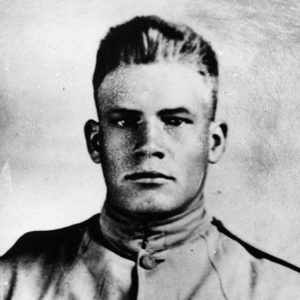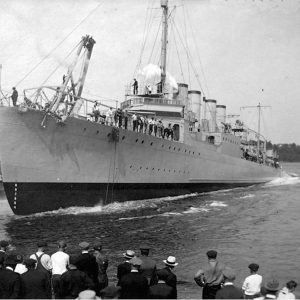calsfoundation@cals.org
USS Pruitt
The USS Pruitt was a Clemson-class destroyer built in 1919 and named for John Henry Pruitt, an Arkansas native who won two Medals of Honor for gallantry during World War I.
John Henry Pruitt was born on October 4, 1896, in rural Newton County near the community of Fallsville. Pruitt joined the U.S. Marine Corps shortly after the United States entered World War I. On October 3, 1918, during the battle for Mont Blanc Ridge, Corporal Pruitt single-handedly attacked and destroyed two German machinegun nests before capturing forty enemy soldiers in an adjoining trench. Wounded by shellfire, he died the next day—his twenty-second birthday. Both the U.S. Army and U.S. Navy awarded Pruitt a Medal of Honor for his actions on Mont Blanc Ridge.
The USS Pruitt’s keel was laid down on June 25, 1919, at the Bath Iron Works in Bath, Maine. It was launched on August 2, 1920, and christened by Belle Pruitt, the late corporal’s mother. The Pruitt was commissioned on September 2, 1920, under Lieutenant M. R. Derx. The 1,215-ton destroyer was 314 feet long, thirty-two feet wide, and could reach speeds of thirty-five knots. Carrying a crew of 114 men, it was armed with four four-inch guns along with several anti-aircraft batteries.
The Pruitt was converted to service as a light mine-layer (DM-22) on June 30, 1937, and spent the majority of its time between the world wars in the Far East. It was undergoing an overhaul at Pearl Harbor when Japanese planes attacked the base on December 7, 1941. After the overhaul was completed in January 1942, the Pruitt patrolled and laid mines around Hawaii until June, then went to Alaska for mine-laying and escort duties out of Kodiak. For the bulk of the year, the Pruitt made runs between the Aleutians and Hawaii before heading for the mainland for escort service along the West Coast.
Training with the Fourth Marine Raider Battalion off the southern California coast at the start of 1943, the Pruitt returned to the Aleutians in April. It escorted landing craft into Massacre Bay on May 11 as U.S. forces attacked Japanese troops who had seized the island of Attu in the Aleutians, a battle that ended with U.S. victory on May 30. The Pruitt returned to the mainland on June 6 and operated along the West Coast from Alaska to California. It sailed to the Solomons in September and laid mines along Bougainville’s southern coast during November, later escorting vessels between the Solomons, New Hebrides, New Caledonia, and the Society Islands.
Returning to San Francisco, California, on July 18, 1944, the Pruitt underwent an overhaul before returning to Hawaii for submarine training operations in October. The vessel patrolled off Midway between November 1944 and January 1945, then spent the rest of World War II training submarines off Oahu.
The Pruitt was re-designated as AG-101, an auxiliary general classification, on June 5, 1945, and ordered to Philadelphia, Pennsylvania, that fall. The Pruitt was decommissioned on November 16, 1945, and struck from the navy list on December 5, having earned three battle stars. It was broken up for scrap in the Philadelphia Navy Yard in 1946.
For additional information:
“Pruitt (DD-347).” Dictionary of American Fighting Ships. Naval History and Heritage Command. https://www.history.navy.mil/research/histories/ship-histories/danfs/p/pruitt.html (accessed July 13, 2018).
“USS Pruitt (DD-347/DM-22/AG-101).” NavSource.org. http://www.navsource.org/archives/05/347.htm (accessed July 13, 2018).
Mark K. Christ
Little Rock, Arkansas
 Early Twentieth Century, 1901 through 1940
Early Twentieth Century, 1901 through 1940 Military
Military John Pruitt
John Pruitt  USS Pruitt
USS Pruitt 




Comments
No comments on this entry yet.